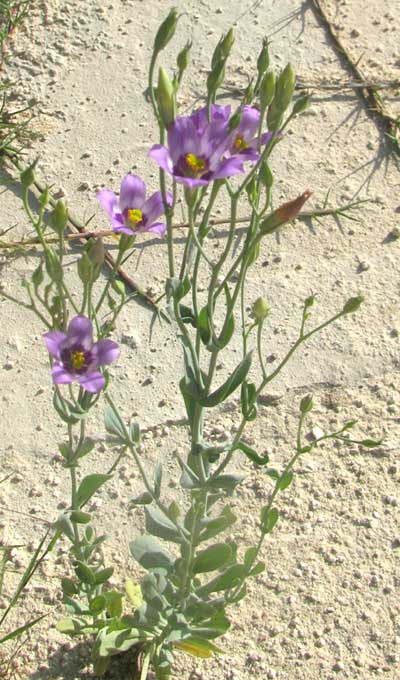Excerpts from Jim Conrad's
Naturalist Newsletter
from the May 1, 2011 Newsletter issued from Mayan Beach Garden Inn 20 kms north of Mahahual; Caribbean coastal beach and mangroves, ~N18.89°, ~W87.64°, Quintana Roo state, MÉXICO
SEASIDE GENTIAN
I'm on a narrow sand ridge between the ocean to the east and extensive mangrove swamp to the west. Organisms occupying this sand-ridge environment deal with extreme environmental conditions -- sizzling heat, dazzling sunlight on white sand, sand through which rainwater drains very quickly leaving very dry rooting conditions, and everything is salty.
A knee-high plant flowering nowadays not looking nearly tough enough to survive such extremes is shown below:

A close-up showing the spectacularly patterned interior of a two-inch-across (5cm) flower is shown below:

This pretty member of the Gentian Family, common along roadsides, is native not only to much of Mexico, the West Indies and parts of South America, but also to the US where it's found from Florida west to California and north in the interior to Montana and South Dakota. Since it's so eye-catching, it goes by many common English names, including Catchfly Prairie Gentian, Showy Prairie Gentian, Bluebell Gentian, Western Blue Gentian, Blue Marsh Lily, Small Bluebell, Catchfly Gentian, Catchfly Prairie-Gentian, Beach Gentian, Seaside Gentian and in Texas of course they call it the Texas Bluebell. Since here we're on the beach, I'll call it Beach Gentian. It's EUSTOMA EXALTATUM.
Though it's in the Gentian Family, it's not really a gentian. To be a gentian it'd have to belong to the genus Gentiana, but you see that it's in the genus Eustoma.
Not only is Beach Gentian widely distributed, but also it's highly adaptive, living in sandy coastal areas such as ours as well as moist places in prairies and fields, and saline to freshwater marshes.